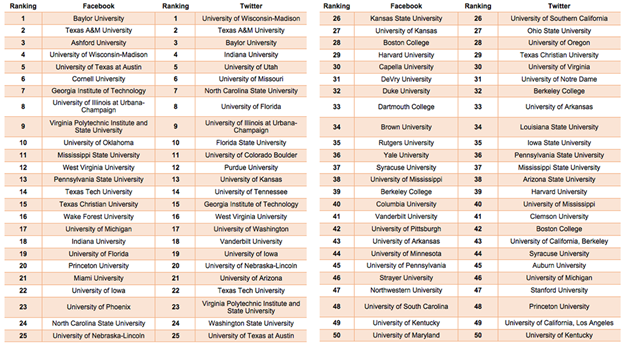Engagement, impact and responsiveness were all key to landing a spot on the list of the best institutions on social media.
Technology and data company Engagement Labs released its 2016 ranking of the top 50 U.S. colleges and universities on social media networks Facebook and Twitter.
As the higher education landscape becomes more competitive than ever, social media has become an increasingly important way for colleges and universities to gain an edge over one another. Social media is especially helpful for schools not only with regards to recruitment and retention, but also to communicate with current and prospective students in a timely and effective manner that matches their tastes.
“Some people might look at social media as, ‘what’s the cost of doing it?’,” said Bryan Segal, CEO of Engagement Labs. “These days, though, it’s ‘what’s the cost of not doing it?’ Social media helps colleges and universities on multiple fronts, including the acquisition of new students, staying in touch with alumni, and building communities. Colleges are all about community. Being able to use a channel like social media is important for where they were, are, and need to be with the demographics they’re trying to reach.”
“There’s not a huge barrier to entry, so it’s all about tactics,” he emphasized.
The colleges and universities examined included those categorized as Ivy League, for-profit, and those within the following NCAA conferences: the Big ten, the Big 12, the ACC, the Pac-12 and the SEC. Also, while the company measures content across numerous social media networks, they decided to focus on the two that they found to be the most impactful and active, which were Facebook and Twitter.
The rankings were assembled based on data compiled by the company’s own eValue Analytics scores. This system was created to offer ongoing third party, competitive benchmarking data analytics based on a worldwide scoring system to accomplish somethign similar to what Neilson does for Television. The eValue score is comprised largely of three sub-scores:
Engagement – The amount of content and participation between consumers and a brand. This includes how many posts, tweets and images an institution puts out, as well as how many likes or retweets they get.
Impact – How large a reach an institution’s social media presence encompasses.
Responsiveness – How a brand responds to, and interacts with, its consumer base. This includes how often they respond to followers’ posts, how long it takes for them to do so, and the quality of the response.
(Next page: The rankings of the top 50 institutions on social media)

“On Facebook, we found that many of the colleges and universities identified the right type of content that encourages its followers to engage, as indicated by the high Engagement scores across the board,” said Segal. “While social channels create ample opportunity for recruitment and school promotion to students, they also allow for engaging alumni and parents.”
Baylor University came in first place on Facebook with the highest overall eValue score. Baylor had the highest Engagement score due to posting high-quality content revolving around its football team and campus, which encouraged their followers to interact with them often. As a result, Baylor generated the highest number of comments and likes per 1,000 fans and had the most active user base in the top 10.
Texas A&M University had the second highest eValue score overall, with the highest amount of total likes and comments for their content that was largely based on school pride. In third place was Ashford University, which had the highest Responsiveness of the group thanks to their humorous posts.
Meanwhile on Twitter, University of Wisconsin-Madison ranked first for overall eValue score, and boasted the highest number of retweets and favorites per 1,000 followers.
“Wisconsin led in a substantial way thanks to a combination of humor, GIFs and witty comments,” said Segal. “They had an explosion of content and with it came the highest amount of retweets and favorites. Their tweets had a lot of shareability and impact throughout their community.”
As they were with Facebook, Texas A&M University also ranked second on the Twitter rankings, with the highest Impact score as well as the largest growth of followers in the top 10, with 25,515 new followers in the past year. Baylor University similarly had a strong showing on Twitter as well, coming in at third place and claiming the highest Engagement score of the top 10 thanks to a content-focused strategy similar to their Facebook channel.
Responsiveness is crucial to success
Fifth place finisher University of Utah scored the highest Responsiveness rate of the top 10 on Twitter.
“Engagement may be high across both channels, but the lower Responsiveness scores – particularly on Twitter – showcase a need for these academic institutions to place more emphasis on their response strategies to participate in two-way communication,” said Segal. “Followers are turning to these channels for answers regarding topics such as academic needs or campus life, so providing the requested information via social is essential to the promotion of their brand.”
Despite a slight shakeup in the rankings, many of the top contenders this year were also in the top tier of institutions last year as well. However, many schools also joined the list or fell off due to different tactics being used this year and the overall evolution of social media.
As for advice on how schools can improve their social media strategies?
“Colleges need to ensure quality and talk to their audience if they want great, shareable, talkable content,” said Segal. “When someone talks to you, make sure to talk back. An institution needs humans, a brand message, and the ability to execute it. How you use a channel is very important, and you need a direct marketing strategy for social. Overall, an effective response strategy helps build relationships with students, prospects and the community-at-large.”
Overall, identifying a target group, message, tactics, frequency, advertising and marketing plans are all of the utmost importance for any institution looking to make it on this top 50 list.
“We’re inspired by the sort of activity we’re seeing, and the evolution of that activity over time” said Segal. “Scores are increasing with the overall uplift of activity that’s occurring, and we look forward to continuing to see the evolution of content and tactics.”
For more on Engagement Labs, click here.
- 4 reinvention best practices from across the pond - August 29, 2016
- New tool plays admissions matchmaker - August 15, 2016
- New tech to revolutionize studying abroad education - July 5, 2016

